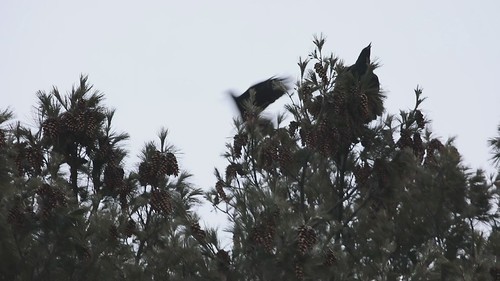Wednesday, March 18, 2020
Cacawphony
On Monday, I heard crows calling loudly, so I grabbed my binoculars and camera and headed a couple of blocks away to where a host of about 60 crows were gathered, screaming bloody murder, which is actually why this kind of gathering is called a "murder of crows." The cacophony, or in this case a cacawphony, was drawing in crows, one raven, and a couple of Blue Jays from far and wide, all because a Great Horned Owl was tucked into the dense upper branches of a big pine. I got a glimpse of the owl’s belly when the wind moved some of branches exactly right, but simply could not get a photo, though I of course photographed the crows.
I knew the owl was somewhere in the neighborhood because I’d heard it calling the night before. Usually when crows mob an owl, it’s at least a little easier to get a good view of the owl, but this one was rooted in the thick branches. Occasionally one or two crows would go on a quick dive-bombing mission, but the owl was safer staying where it was than trying to get away from them. In flight by day, crows are faster and more maneuverable than owls. They would have followed it, stabbing it in midair, and then started up the harassment wherever the owl alighted all over again.
The reason crows attack owls so vigorously is that Great Horned Owls kill crows by night, when crows in their roosts are usually immobile. I’ve heard in recent years that some people are noticing crows flying about at roosts throughout some nights, but those have all been at urban roosts in areas with light pollution. When I rehabbed adult crows and needed to replace bandages or otherwise handle them, I always did it in the room where I housed the crow, always dark at night, and I used a flashlight—even the feistiest crow by day was as docile as a dishrag by night.
Great Horned Owls that come upon a crow roost capitalize on that docility to sometimes kill a dozen or more. They aren’t actually eating crow, at least not the whole body—to minimize blood on their facial feathers, they tend to make a clean cut by lopping off the head and swallowing it whole. That’s why when a Great Horned Owl discovers a crow roost, it usually takes out several rather than just one. It’s also why when crows spot an owl roosting by day, they try to drive it off—not so much out of revenge or hatred but rather to prevent the owl from noticing where the crows head to roost at day’s end. The crows may or may not be thinking about this or doing it with intention, but they're certainly being crowactive.
It was cold and windy out there, so I didn’t stay out long.
After making a short video and taking several photos of the crows, I headed home. I’d been hearing a distant cardinal, and as I got closer to home, started hearing a robin—the first one I’ve heard in 2020. It was making its low-grade alarm calls and looking pretty miserable sitting up in a bare tree. I took a few photos, and suddenly he broke into song! Oddly enough, although the song was perfect, he was singing it sotto voce. I made a very poor video, but the song was pretty quiet against the background noise.
I couldn’t help but feel sorry for the poor guy, out there on such a miserable day, but those first returning robins tend to be in very good physical shape when they leave their wintering ranges. Worms are staying deep in the frozen soil still, but robins can live for quite a while on berries alone, the main staple of their winter diets in many places. So seeing and hearing my first robin of spring was a most hopeful development. I may be stuck at home, but that was a genuinely joyful experience.



